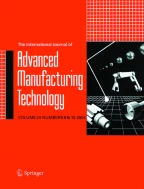Abstract
This study was realized with two different types (flat and thread rolled) of coated (TiAlN), uncoated, and cryogenically treated taps (uncoated). The tapping processes were carried at four different cutting speeds (2, 3, 4, and 5 m/min) and 1.25 mm/rev feed rate under dry and wet cutting conditions on the Ti-6Al-4 V alloy. The measured cutting forces (cutting torque) were evaluated according to the cutting tool and cutting parameters. The best results in terms of cutting torque were obtained with straight flutes with spiral point taps. For the coated cutting tools, it was seen that the cutting torque was higher with respect to the other tools. The cutting fluid caused decreases in cutting forces for both of the cutters. Under dry cutting conditions, in the cryogenically treated tool, cutting torques came out to be lower with respect to the coated and uncoated tool.
Similar content being viewed by others
References
Nabhani F (2001) Machining of aerospace titanium alloys. Robot Comp Integ Manuf 17:99–106
Ezugwu EO, Wang ZM (1997) Titanium alloys and their machinability—a review. J Mater Process Technol 68:262–274
Ensarioğlu C, Çakır MC (2005) Titanyum ve alaşımlarının işlenebilirlik etüdü. Mühendis ve Makine 46(546):1–7
Kishawy HA, Wilcox J (2003) Tool wear and chip formation during hard turning with self-propelled rotary tools. Int J Mach Tool Manuf 43:433–439
Schueller JK, Tlusty J, Smith S, Leigh E (2000) Advanced machining techniques on titanium rotor parts. American Helicopter Society Virginia, pp 1–7
Nabhani F (2001) Wear mechanisms of ultra-hard cutting tools materials. J Mater Process Technol 115:402–412
Haron CHC, Jawaid A (2005) The effect of machining on surface integrity of titanium alloy Ti6Al4V. J Mater Process Technol 166:188–192
Jawaid A, Che Haron CH, Abdullah A (1999) Tool wear characteristics in turning of titanium alloy Ti-6246. J Mater Process Technol 92–93:329–334
Benes J (2012) Cool tips for cutting titanium. http://www.americanmachinist.com/304/Issue/Article/False/77297/
Kitagawa T, Kubo A, Maekawa K (1997) Temperature and wear of cutting tools in high-speed machining of Inconel 718 and Ti-6Al-6 V-2Sn. Wear 202(2):142–148
Riberiro MV, Moreira MRV, Ferreira JR (2003) Optimization of titanium alloy (6Al4V) machining. J Mater Process Technol 143–144:458–463
Yong AYL, Seah KHW, Rahman M (2007) Performance of cryogenically treated tungsten carbide tools in milling operations. Int J Adv Manuf Technol 32:638–643
Huang JY, Zhu YT, Liao XZ, Beyerlein IJ, Bourke MA, Mitchell TE (2003) Microstructure of cryogenic treatment of tool steel. Mater Sci Eng, A 339:241–244
Collins DN (1996) Deep cryogenic treatment of tool steels: a review. Heat Treat Met 23:40–42
Da Silva FJ, Franco DD, Machado AR, Ezugwu EO, Souza AM Jr (2006) Performance of cryogenically treated HSS tools. Wear 261:674–685
Mohan Lal D, Renganarayanan S, Kalanidhi A (2001) Cryogenic treatment to augment wear resistance of tool and die steels. Cryogenics 41:149–155
http://www.guhring.com.tr/Upload/Document/document_3c5f4d55a196484184ceedddb32a1341.pdf (2012)
Kuo K (2007) Experimental investigation of ultrasonic vibration-assisted tapping. J Mater Process Technol 192–193:306–311
Li W, Li D, Ni J (2003) Diagnosis of tapping process using spindle motor current. Int J Mach Tool Manuf 43:73–79
Ay İ, Demircioğlu TK (2005) Kesme ve ovalama yolu ile cıvata-vida dişi imalat yöntemlerinin kıyaslanması. Makina Magazin Dergisi 10:64–67
Cao T, Sutherland JW (2002) Investigation of thread tapping load characteristics through mechanistic modeling and experimentation. Int J Mach Tool Manuf 42:1527–1538
Reiter AE, Brunner B, Ante M, Rechberger J (2006) Investigation of several PVD coatings for blind hole tapping in austenitic stainless steel. Surf Coatings Technol 200:5532–5541
Veldhuis SC, Dosbaeva GK, Benga G (2007) Application of ultra-thin fluorine-content lubricating films to reduce tool/workpiece adhesive interaction during thread-cutting operations. Int J Mach Tool Manuf 47:521–528
Jin M, Watanabe S, Miyake S, Murakawa M (2000) Trial fabrication and cutting performance of c-BN-coated taps. Surface Coat Tech 133–134:443–447
Armarego EJA, Chen MNP (2000) Predictive cutting models for the forces and torque in machine tapping with straight slute taps. Department of Mechanical and Manufacturing Engineering, The University of Melbourne Australia
Dogra APS, Kapoor SG, Devor RE (2002) Mechanistic model for tapping process with emphasis on process faults and hole geometry. J Manuf Sci Eng 124(18)
http://www.emugedownloads.com/pdf/prospekte/multi/zp10015_tr.pdf, (2010)
Yong AYL, Seah KHW, Rahman M (2008) Performance evaluation of cryogenically treated tungsten carbide, tools in turning. Int J Mach Tool Manuf 47:754–759
SreeramaReddy TV, Sornakumar T, VenkataramaReddy M, Venkatram R (2009) Machinability of C45 steel with deep cryogenic treated tungsten carbide cutting tool inserts. Int J Refrac Met Hard Mater 27:181–185
Uygur I (2006) Microstructure and wear properties of AISI 1038H steel weldments. Ind Lubric Tribol 58:303–311
Author information
Authors and Affiliations
Corresponding author
Rights and permissions
About this article
Cite this article
Uzun, G., Korkut, İ. The effect of cryogenic treatment on tapping. Int J Adv Manuf Technol 67, 857–864 (2013). https://doi.org/10.1007/s00170-012-4529-x
Received:
Accepted:
Published:
Issue Date:
DOI: https://doi.org/10.1007/s00170-012-4529-x



